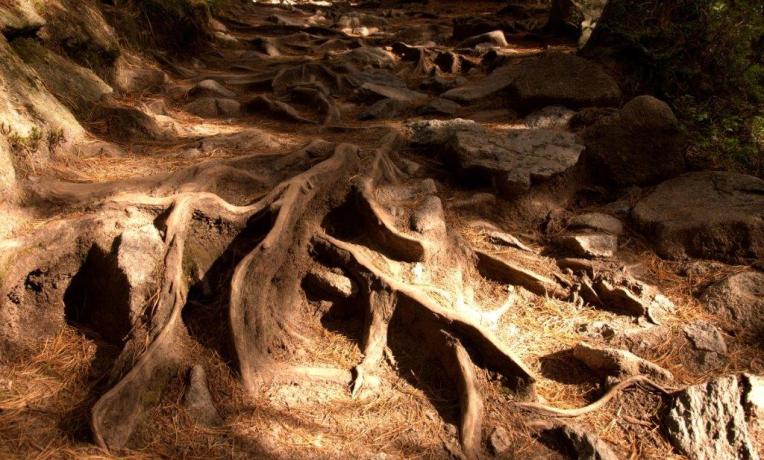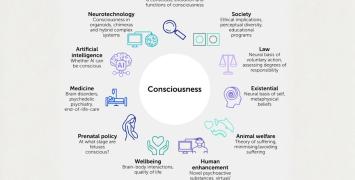Unearthing the social network of trees

Beneath forest floors, a complex underground web of roots, fungi and bacteria connects trees and plants to one another and nourishes the forest. This subterranean network plays a crucial role in limiting the effects of climate change, although much of its workings are still unknown. ERC grantee Barbara Mazzolai seeks to unearth these natural processes using robotics. Her ultimate aim is to help find sustainable solutions to preserve the network’s role in safeguarding biodiversity.
Above ground, plants remove carbon dioxide from the atmosphere by photosynthesis and purify the air, therewith helping to offset global climate change. Similar processes happen beneath the soil. Trees give carbon to fungi living on their roots in exchange for essential nutrients, like nitrogen, phosphorous and potassium, which they take up from the soil.
These fungi are essential for the growth and the health of trees. They form an underground hyphal network that joins individual plants to one another. This collaborative structure, called the Wood Wide Web, also allows plants to distribute resources such as water and minerals between one another. For instance, a dying tree might divest itself of its resources to the benefit of others; ‘adult’ trees can share nutrients via the fungi to young seedlings.
A delicate balance
The trees’ ‘social network’ plays a crucial role in maintaining healthy ecosystems below and above ground. Worryingly, rising temperatures around the globe triggered by climate change are set to disrupt the natural relationship between fungi and plants roots, drying out forests and limiting the Wood Wide Web’ s ability to act as a reservoir for excess carbon dioxide.
“Recent research shows that plants and trees are extremely vulnerable to the effects of climate change because it changes their mechanisms, structure and environmental conditions”, says Barbara Mazzolai. “It is fundamental to preserve the delicate balance underneath our feet, which is essential for every form of life on earth. But before we are able to develop preservation strategies, we need to gain a deeper understanding of the symbiotic relations between fungi and plants that govern the World Wide Web.“
Plants behaviour
Mazzolai’s passion for fungi and soil microorganisms dates back to her childhood when her father took her for walks in the woods surrounding her hometown. As a biologist, she deploys innovative technology for her research. Her team combines expertise in biology, material science, engineering, Artificial Intelligence and biomechanics to develop an artificial system that mimics plants behaviour, including their unique ability to live and operate in fungi networks.
“When plants are connected to one another, they enhance their abilities, with an emerging collective behaviour that allows them to solve complex problems and go beyond the capabilities of a single plant,” says Mazzolai. “Our knowledge about how this exactly happens is still limited. We need some devices to observe and study these phenomena. We are trying to recreate in the lab what happens in nature using soft robotics, intelligent systems and collective robotics.”
Sophisticated robots
The plant-inspired prototype consists of soft robotic plant roots made of multi-functional materials and printed composite hydrogels, which is adaptable to interact with the environment. From this plant model, the team will create soft robotic networks to simulate plant-fungal networks. These sophisticated robots will be able to explore soil using their roots in response to their augmented environmental perception of the underground networks. Additionally, they will have growing, ageing, branching, and elongating abilities just as plants do, and the team will test their ability to interact with real plants.
“Robotics is a great tool for increasing our knowledge of complex systems such as the plant world, but also of space and the ocean’s abysses”, Mazzolai says. “Using robotics in biology to understand trees’ behaviour will hopefully in the long run lead to real solutions to preserve ecosystems such as the Wood Wide Web. Trees and plans have an important role to play in maintaining the conditions for the survival of other species, including for us, humans. “
Biography
Barbara Mazzolai is Associate Director for Robotics and Director of the Bioinspired Soft Robotics Laboratory at the Istituto Italiano di Tecnologia (IIT). From 2011 to 2021, she was the Director of the IIT Center for Micro-BioRobotics (CMBR). She graduated in Biology (with Honours) from the University of Pisa, Italy, and received a Ph.D. in Microsystems Engineering from the University of Rome Tor Vergata. From January to July 2017, she was Visiting Faculty at Aerial Robotics Lab, Department of Aeronautics, of Imperial College of London. She is member of the Scientific Advisory Board of the Max Planck Institute for Intelligent Systems, and member of the Advisory Committee of the Cluster on Living Adaptive and Energy-autonomous Materials Systems – livMatS.






